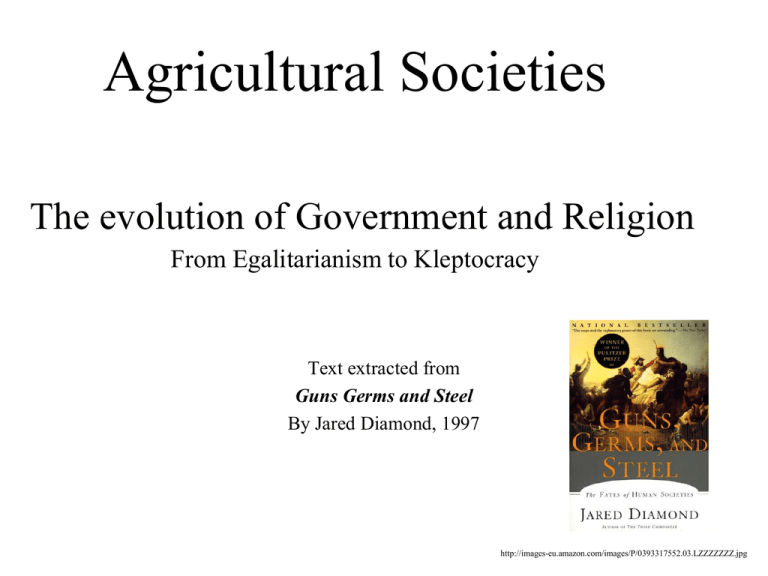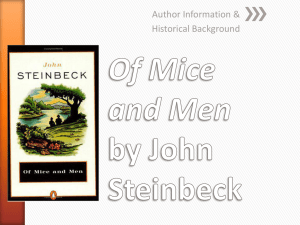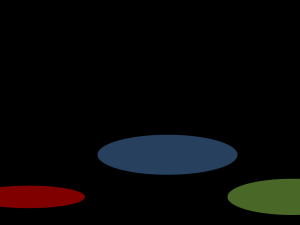Agricultural Societies
advertisement

Agricultural Societies The evolution of Government and Religion From Egalitarianism to Kleptocracy Text extracted from Guns Germs and Steel By Jared Diamond, 1997 http://images-eu.amazon.com/images/P/0393317552.03.LZZZZZZZ.jpg Government and Religion • Descendents of those societies that earliest achieved – centralized government – organized religion • ended up dominating the modern world http://www.historyofjihad.org/crusades2.jpg Government and Religion • 4 main forces of history: • Resulting in the broadest patterns – – – – Babylon http://web.njit.edu/~turoff/image/tower-of-babel.jpg government & religion germs writing technology Government and Religion • How did government and religion arise? • How did they become combined? King Solomon http://www.flholocaustmuseum.org/history_wing/antisemitism/arts/visual_arts.cfm Levels of Social Organization • • • • China: early state society http://www.travel-centre.co.uk/site-media/images/sections/great_wall_1.JPG Bands Tribes Chiefdoms States Bands • Tiny Populations: typically 5-80 people • Most are close relatives by birth or marriage • All humans lived in bands until 40,000 years ago In recent history: – African Pygmies, Bushmen – Australian Aborigines – Eskimos Bushman http://www.south-africa-tours-and-travel.com/images/bushman-hunter-gathere-rsa-xauslodge.jpg Bands • Usually nomadic: – live in areas where food is scarce • Land used by whole group • No specialization: – all able-bodied individuals forage for food • Economic system: – Reciprocal Exchange • No laws, police, or treaties to resolve conflicts: – But being closely related helps Bands • No stratification into classes • Egalitarian leadership based on – – – – personality strength intelligence fighting skill Australian Aboriginal http://www.janesoceania.com/australia_aboriginal_history/Aboriginal%20Jimmy%20Walkabout_%20pitjantjara_tribe.jpg Fayu in New Guinea • Four clans totaling 400 people • Normally live as single families • • • • scattered in swampy area Come together once or twice a year to negotiate brides Formerly numbered 2,000 Population reduced by Fayu killing Fayu Lacked political and social mechanisms to resolve disputes Tribes • Society with hundreds of • • • • • http://lamar.colostate.edu/~lctodd/image1.gif people, usually settled in many villages Few left today Shared language and culture More than one clan (kinship group) Land belongs to clans within a tribe Everyone knows everyone else by name and relationship Tribes • Conflicts still solved by being closely related • If two New Guinea Tribesmen were both away from their villages and happened upon one another • They would engage in a long discussion to determine possible family ties • Otherwise, no reason not to kill one another http://www.theage.com.au/ffximage/2006/09/17/18W_PNG_narrowweb__300x334,0.jpg Tribes • Social System egalitarian • No upper or lower class • Each has debts and obligations to • • • • many others No one can become more wealthy Government still egalitarian Decisions are made in a group “Big Man” would have limited power – may look and live like everyone else Tribal chief, Brazil http://vervephoto.files.wordpress.com/2008/03/taitiana_brasil.jpg Reciprocity • Reciprocity was the Basis of Early Economic Systems Reciprocity • Gift giving creates an obligation to • • • • • http://www.thorstenconsulting.com/Shaking%20hands.jpg return similar gifts Feasting improves relations, prevents hostility, is an excellent way to “store” food Reciprocity leads to intermarriage Villages are connected by multiple ties of kinship Reciprocity results in food security, balances inequities Political leadership is bestowed on those that give the most Kerekere in Moala • Moalans live in 1200 scattered • • • • • http://www.gfmer.ch/Medical_search/Countries/images/Fiji_map.gif villages in Fiji Pacific Islands Kerekere is a formal request for a good or service Can only kerekere a relative, but everyone are relatives Are duty bound to honor a kerekere if you have what is asked for This system evens out inequity Prestige comes from giving more than taking Hunting and Gathering Societies Government Bands and Tribes Egalitarian Economy Hunting & Gathering Reciprocal Exchange Ideology Nature Religions God and Goddess Worship Chiefdoms • Population: several thousand to tens of thousands • Arose about 7,500 years ago with rising populations • In 1492, widespread in – N. and S. America – Africa – Polynesia http://www.tngenweb.org/maps/eastribe.jpg Chiefdoms • No chiefdoms left in 20th century • Prime land taken by larger state societies • Chiefdoms consolidated into states http://www.alohaislandtravel.com/maps/images/islands.gif Chiefdoms • Usually have Public Architecture – Temples – Tombs Easter Islands http://www.mattnortham.com/blog/wp-content/images/2007/01/easter-island.jpg Chiefdoms • Most people unrelated to others • People don’t know most others by name • For first time in history, – people had to learn how to encounter strangers regularly – without attempting to kill them http://upload.wikimedia.org/wikipedia/commons/thumb/d/d7/De_Bry_Chief_Virginia.jpg/761pxDe_Bry_Chief_Virginia.jpg Chief • Held monopoly on right to use force • Held recognizable, hereditary office • Wore distinguishing clothes: demanded respect http://www.indianahumanities.org/Wethepeople/203/Indian_Chief_with_Head_Dress.jpg Chief • Was thought of as a god – or had a hotline to the gods • Centralized authority: – Monopoly on information – Levels of Bureaucrats work under Chief – Many specialized jobs that can be done by slaves Redistributive Economy • Chief receives food from everyone, then – Throws feast to redistribute – Stores it for later redistribution – Keeps much of it himself (tribute) • Chief also claims labor for construction of public works: 20,000 workers built the Taj Mahal http://blog.lib.umn.edu/drube004/architecture/image/Taj%20Mahal.jpg – Irrigation, – Lavish Tombs Redistribution • Chief receives foodstuffs, goods from many – because he has power • Chief has power because – he regularly directs a flow of goods to his followers • Early city-states operated on this principle http://www.planetware.com/i/photo/acropolis-parthenon-athens-gr003.jpg Traders • Traders did not make a profit – were agents of the empire • Goods traded on a fixed-price basis • Did not buy low and sell high http://www.uncp.edu/home/rwb/camel_caravan.jpg Luxury Goods • Food surpluses generated by common people feed – Chief – Bureaucrats & Priests – Craft Specialists • Luxury Goods reserved for Chiefs http://farm2.static.flickr.com/1316/1172894001_f8a4dc5f67.jpg?v=0 Contribution Enforced • In Mesopotamia, police ensured that farmers contributed • Impersonality of city life – ends feelings of obligation of Chief to people – or vice versa http://farm2.static.flickr.com/1073/577047551_3eae5c5653.jpg?v=0 Good Chiefdoms • Good chiefdoms used tribute to provide important services to entire society – Irrigation – Religion – Defense Roman Aqueduct http://farm1.static.flickr.com/30/44052812_a0e766a843.jpg Kleptocracies • At worst, chiefdoms were kleptocracies • Transferred net wealth from commoners to upper class http://lh3.ggpht.com/_oZMEAvLIJ70/Rz6D4tvSEuI/AAAAAAAAAOo/upBtJBKnEIU/DSCN3213.JPG Kleptocracies • How do kleptocracies keep from being overthrown? – Disarm the populace • arm the elite – Redistribute tribute in popular ways – Use monopoly of force to keep public order – Construct an ideology or religion • that justifies kleptocracy http://library.thinkquest.org/C0110901/imagesAll/emperor.jpg State Religion • Provides bond between people – not based on kinship – keeps them from killing each other • Gives warriors a motive for sacrificing life in battle: – now much more effective in conquest http://attendingtheworld.files.wordpress.com/2007/08/crusades.jpg States • Populations of 50,000 to • • • • Babylon 1 Billion Usually literate elites sometimes literate population Arose 3,700 BC in Mesopotamia Later in Mesoamerica, China, Southeast Asia, Andes, West Africa http://upload.wikimedia.org/wikipedia/commons/thumb/e/e1/Brueghel-tower-of-babel.jpg/795px-Brueghel-tower-of-babel.jpg Earliest States http://www.hyperhistory.com/online_n2/History_n2/a.html States • True cities, characterized by – Monumental public works – Palaces of rulers – Accumulation of capital from tribute or taxes – Concentration of people other than food producers http://www.evcal.org/sitebuilder/images/Luxor094KarnakStatue-373x496.jpg States • Early states: – hereditary leader equivalent to a king • Democracies today: – crucial knowledge still available to only a few • Central control, redistribution of tribute more far-reaching – Even farmers not selfsufficient http://www.woodlands-junior.kent.sch.uk/Homework/egypt/images/harvest.jpg Mesopotamia • Food produced by 4 specialist groups – – – – http://farm1.static.flickr.com/9/14160477_43e502cb7c.jpg Cereal farmers Herders Fishermen Orchard and Garden growers Mesopotamia • State took produce from each farming group • Redistributed necessary supplies – and the other foods not produced • Exchanged wool by long distance trade – for other essential raw materials • Paid food rations to laborers – who maintained irrigation systems for farmers http://www.edupic.net/Images/SocialStudies/mesopotamia_ashurnasirpal2.jpg Slavery • Many states adopted slavery on Mesopotamian slaves http://www.uned.es/geo-1-historia-antigua-universal/ACADIOS/slaves_stele.jpg much larger scale than chiefdoms because – More use for slave labor – More economic specialization – More mass production – More public works – Warfare on a larger scale • meant more captives available Bureaucracies • • • • More complex bureaucracies Formalized laws, judiciary, police Laws often written (by literate elite) Writing not developed until formation of state societies – Mesopotamia – Mesoamerica Code of Hammurabi, Mesopotamia http://www.allaboutarchaeology.org/images/code-of-hammurabi.jpg Religion • Early: state religions – standardized temples • Many kings divine • Kings often head of state Mesopotamian Temple http://i143.photobucket.com/albums/r127/andrewidodo/600ziggurat.jpg religion • Mesopotamian Temple was center of – Religion – Economic redistribution – Writing – Crafts technology Expansion of Agricultural Societies Small Conquest Land Agriculture Group Slaves Expanded Food Population Conquest Etc. Technology Agricultural Societies Government Chiefdoms, States Kleptocracies, Elites Kings = Gods Economy Agriculture Redistribution, Tribute Conquest, Slavery Ideology State Religions Central Temple Male dominated Agricultural Society Hierarchy Elite Conquest Wealth, Tribute Food, Resources Conquered & Exploited: Peasants, Slaves, Workers Wealth and Poverty Elite Wealth, Tribute Wealth: Own land, Well-fed Educated, Health care, Opportunities Food, Resources Conquered & Exploited: Peasants, Slaves, Workers Poverty: Landless, hungry, uneducated, unhealthy, no opportunities Organization of States • States organized on Roman Empire http://gbgm-umc.org/UMW/corinthians/maps/empire2a.gif political and territorial lines: not kinship and tribe boundaries • States and empires often are multiethnic and multilingual • Bureaucrats selected more on ability than heredity • Modern states have nonhereditary leadership Why Do States Arise? • More complex societies usually conquer less complex ones • Advantage of weapons, technology, numbers • Centralized decision making more efficient in conquest • Official religions, patriotic fervor – make troops willing to fight suicidially: fanaticism Arab Muslim Empire http://www.ac.wwu.edu/~helfgott/img/map-arab-empire.png How Do Chiefdoms Become States? • Aristotle: – States are the natural condition of human society. • Knew only Greek Societies of 400 BC • Rousseau: – States formed by a social contract – a rational decision of people based on self interest. • Never happened this way • Small groups do not give up their sovereignty willingly Aristotle http://www.empirecontact.com/magicstar/Aristotle.jpg Irrigation Theory • Major civilizations had largescale irrigation: – – – – Mesopotamia, Egypt China Mesoamerica • Large-scale irrigation requires centralized bureaucracy for Irrigation, Egypt http://www.love-egypt.com/images/egypt-agriculture.jpg – Construction – Maintenance – Management Irrigation Theory Disputed • States formed to create irrigation systems? – But irrigation came after states formed • States did not always have centrally controlled irrigation Hanging Gardens, Babylon http://www.expandmywealth.com/wp-content/uploads/2008/02/hanging-gardens-of-babylon.jpg Population Theory • Strong correlation between size of population – and complexity of society • Autocatalysis: – population growth leads to social complexity • Social complexity leads to intensified food production Population density http://www.theglobaleducationproject.org/earth/images/final-images/g-gpw-population-map.gif – and population growth Food Production Leads to Social Complexity • Requires seasonal labor. • After harvest, labor used for – public works, – wars of conquest • Stored surpluses permit economic specialization, social stratification: – feed chiefs, elite, scribes, craftspeople, specialists, – feed farmers while they are working on public works http://www.realhistories.org.uk/uploads/images/Tomb_of_Nakht.jpg Food Production Leads to Social Complexity • Sedentary living required for: – – – – – Mayan Temples, Mexico Possessions Technology Crafts public works control of people http://cache.eb.com/eb/image?id=80461&rendTypeId=4 Large Populations Require Complex Social System • Conflict resolution needed between unrelated people: – need laws and authority • Communal decisions impossible: – need structure • Reciprocal economy impossible: – Need redistributive economy • Density of population must be organized Argebam, Iran http://www.tcoletribalrugs.com/resources/Wertime/kerman2.jpg Amalgamation of Smaller Units • Occurs by merger under threat of external force: – 40 Cherokee chiefdoms joined together, – American colonies joined together http://www.scarsdaleschools.k12.ny.us/mslib/images/13colmap.gif Amalgamation of Smaller Units • Occurs by conquest among chiefdoms – Zulu state – Hawaii, Tahiti – Aztecs, Incas • before Spanish arrived – Rome, Macedonian empire – Etc. Roman Expansion http://cache.eb.com/eb/image?id=1040&rendTypeId=4 After Conquest • Bands: – survivors can move away http://culturalsurvivaltrust.org/pix/bandiya_son.jpg After Conquest • Tribes: – – – – Need the land Territory occupied. No need for slaves No need for survivors, • except women as wives – Defeated men are killed http://www.progressdaily.com/wp-content/uploads/2007/07/Yanomamo.jpg After Conquest • States and Chiefdoms – Defeated can be used as slaves – Or defeated can be exploited • left in place to produce food, goods – Deprived of political autonomy – Made to pay taxes, tribute – Amalgamate their society • into victorious state or chiefdom http://www.euro-africsystemsenterprise.org.uk/captured_slaves.jpg Aztec Tribute • Aztec Empire received tribute from its subjects and had tribute lists • Spanish wanted tribute from Mexico • Interested in Aztec Empire’s tribute lists http://www.reformation.org/aztec-empire-map.jpg Aztec Tribute • Each year Aztec subjects paid Aztecs: – – – – 7,000 tons of corn 4,000 tons of amaranth 2,000,000 cotton cloaks Huge quantities of • Cacao beans • war costumes • Shields • feather headdresses • amber Aztec tribute list http://upload.wikimedia.org/wikipedia/commons/thumb/c/c1/Codex_Mendoza_folio_47r.jpg/408px-Codex_Mendoza_folio_47r.jpg






